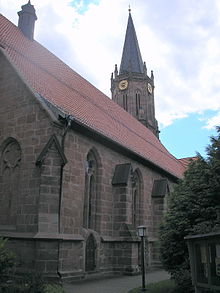St. Aegidien (Heilbad Heiligenstadt)
The Aegidienkirche is a Roman Catholic church in the parish of Sankt Marien Heiligenstadt, newly founded in 2017, in the diocese of Erfurt . In addition to the parish church of St. Marien and the church of St. Aegidien, the parish includes the churches of St. John in Rengelrode and St. Nicholas in Kalteneber. In the parlance of the Heiligenstadt residents, the Aegidienkirche is also called Neustädter Kirche, in contrast to the parish church of St. Marien, which is called the Old Town Church.
history
In the 12th century the market settlement below the Stiftsberg and there the parish church of St. Marien were built . This area is now known as the old town. With the arrival of many professional groups in 1227, the new town with its St. Aegidien Church developed.
This re-establishment was not without controversy. In 1239 the provost of Martinsstift complained that the new church, the patronage of which Archbishop Siegfried II had reserved , was causing him losses, as the patronage of the Marienkirche, which belonged to the monastery, had previously extended over the entire city.
Numerous stays by German bishops - at least 18 between 990 and 1300 - speak for the importance of Heiligenstadt in the Middle Ages. In particular, the ordination of Gerdag as bishop of Hildesheim and Burchard I as bishop of Worms in 990 and 1000 by Archbishop Willigis of Mainz and the consecration of Burchard I of Halberstadt by Archbishop Bardo of Mainz in 1036 underpin the position of Heiligenstadt in the 11th century. and 12th century as the most important residence of the Archbishops of Mainz in today's Thuringia alongside Erfurt.
Around 1850 four teachers were looking for a school order to which they could join. They founded a boarding school in Heiligenstadt to prepare young girls for the teacher examination. This gave rise to the German branch of the Order of St. Maria Postel , also known as the Heiligenstadt Sisters.
church
The church was initially planned with two towers, but then made of sandstone from Lower Saxony as a single tower.
At the end of the 1990s the church was "carefully renovated" in order to preserve the appearance of the joints. Eaves zones and cornices were made functional. Where stone renovation was absolutely not possible on the buttresses, copper was used for covering. Due to the ground in the foundation area and the lateral forces of the vault and roof, the outer walls are not straight, but rather strive outwards with increasing height.
The church was completely repainted as part of the renovation. The cheeks of the stalls (partly different shapes) have been preserved, the organ has been redesigned. The church received new windows, these were previously selected from the designs of seven artists.
The baroque high altar was built between 1689 and 1691. It stood in the Quedlinburg collegiate church until 1938, from where it was removed because of the Romanesque “restoration” - which was the result of the church being rededicated as an “SS consecration place”. He has been in St. Aegidien since 1944.
In the celebration altar are the bones of the two Heiligenstadt patrons, the Mainz bishop Aureus and his deacon Justinus.
organ
The organ in a neo-Gothic case was built in 1908 by the organ building company Klais (Bonn). The instrument was established in 1940 by the organ builder Anton Feith (Paderborn) is a manual work ( Rückpositiv expanded in the gallery balustrade) and electro-pneumatic tracker action changed. Shortly afterwards the organ was rebuilt again and the Rückpositiv removed and installed behind the main organ. The instrument was last rebuilt by the master organ builder Karl Brode (Heilbad Heiligenstadt). Today the instrument has 43 registers on three manuals and a pedal .
|
|
|
|
|||||||||||||||||||||||||||||||||||||||||||||||||||||||||||||||||||||||||||||||||||||||||||||||||||||
- Playing aids:
-
Couple
- Normal coupling: II / I, III / I, III / II, I / P, II / P, III / P
- Super octave coupling: III / I, III / P, III / III
- Crescendo roller
- Swell step for III
-
Couple
Personalities who used to be chaplains in St. Aegidien
- Joachim Meisner (1933–2017), in Heiligenstadt around 1965, Archbishop of Cologne
- Reinhard Hauke (* 1953), in Heiligenstadt around 1980, today Auxiliary Bishop of Erfurt
literature
- Arno Wand: The church “St. Aegidia ”in Heiligenstadt as a municipal citizen church. Study on the 775th anniversary of the Neustadt parish church. In: Eichsfeld-Jahrbuch 10 (2002), pp. 39–60
Web links
- Website of the parish of Sankt Marien
- Site of the Church of Saint Aegidien
- Site of the parish church of Sankt Marien
Individual evidence
Coordinates: 51 ° 22 ′ 35.8 ″ N , 10 ° 8 ′ 11 ″ E



